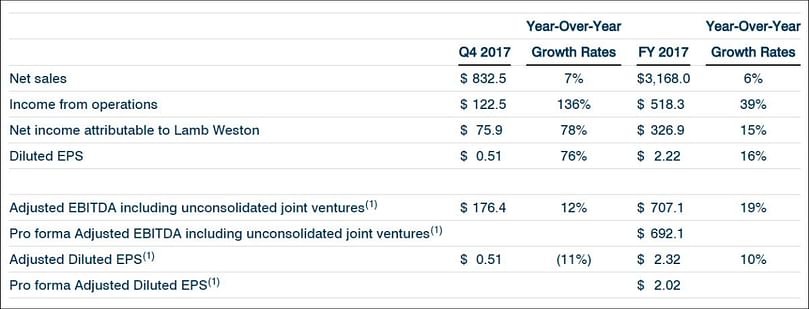Three of Lamb Weston`s featured product: regular cut, sweet potato trim fries and lattice chips.
Potato Processor Lamb Weston Reports FQ4 and Full Year 2017 Results

Lamb Weston Holdings, Inc. (NYSE:LW) has announced its fourth quarter and full year 2017 results, and provided its outlook for fiscal year 2018.
Tom Werner, President and CEO:
“We are pleased with our solid performance in fiscal year 2017, as we continued to deliver high service levels for our customers, while completing the spinoff from Conagra and building a strong foundation for sustainable growth as an independent company.”
“We are also proud of our financial performance for the year as we exceeded each of our financial goals through balanced price/mix and volume-driven sales growth as well as disciplined cost management to expand product contribution margins.”
“Looking ahead to fiscal year 2018, we anticipate the operating environment to remain generally favorable, with solid demand growth for frozen potato products across most of our markets.”
“In addition, we expect the industry’s production capacity to continue to be constrained, especially in North America.”
“We are confident in our ability to build upon the momentum that we have created, leverage our investments in additional capacity to support our customers, execute our strategies and win in the marketplace to deliver on our outlook for the year.”
Summary of Lamb Weston Fourth Quarter and FY 2017 Full Year Results ($ in millions, except per share)
Q4 2017 Commentary
Net sales were $832.5 million, up 7 percent versus the year-ago period. Volume increased 4 percent, with growth across all business segments. Price/mix increased 3 percent due to pricing actions and favorable product and customer mix.
Income from operations rose 136 percent to $122.5 million from the prior year period and included $2.8 million of costs related to the spinoff from Conagra Brands, Inc. (formerly ConAgra Foods, Inc., “Conagra”) and a $3.1 million non-cash gain on assets. Most of the increase reflects the impact of $64.1 million of expenses incurred in the prior year period, including pension charges for actuarial losses and costs related to the spinoff. Excluding these comparability items, favorable price/mix and volume, as well as supply chain efficiency savings, largely drove the growth in income from operations, partially offset by packaging, manufacturing, edible oil and transportation and warehousing cost inflation. In addition, selling, general and administrative expense rose, largely due to incremental costs associated with being a stand-alone public company, as well as higher incentive compensation costs attributable to the Company’s operating performance.
Adjusted EBITDA including unconsolidated joint ventures(1) was $176.4 million, up 12 percent versus the prior year, mainly reflecting higher equity method investment earnings as well as growth in income from operations.
Diluted EPS increased 76 percent to $0.51 from $0.29 in the fourth quarter of fiscal 2016, largely due to pension charges for actuarial losses and costs related to the spinoff from Conagra in the prior year period, higher equity method investment earnings and growth in income from operations. The increase was partially offset by higher interest costs. Adjusted Diluted EPS(1) was $0.51, down 11 percent from $0.57 in the prior year period, primarily due to higher interest costs, partially offset by higher equity method investment earnings and growth in income from operations.
The effective tax rate(2) was 34 percent in the fourth quarter of fiscal 2017.
Q4 Segment Highlight
Net sales for the Global segment, which is comprised of the top 100 North American based restaurant chain customers as well as its international business, increased 6 percent to $421.4 million. Volume increased 4 percent, driven by growth in both domestic and international markets. Price/mix increased 2 percent, largely reflecting price increases and improvement in customer and product mix.
Global Segment Product Contribution Margin(1) increased 10 percent to $83.9 million, primarily driven by favorable volume and price/mix.
Net sales for the Foodservice segment, which services North American foodservice distributors and restaurant chains outside the top 100 North American based restaurant chain customers, increased 9 percent to $277.0 million. Price/mix increased 8 percent, reflecting pricing actions and improvement in customer and product mix. Volume increased 1 percent, largely driven by demand from independent restaurant operators, as well as small and mid-sized restaurant chains.
Foodservice Segment Product Contribution Margin(1) increased 24 percent to $89.3 million, primarily driven by favorable price/mix.
Net sales for the Retail segment, which includes sales of Alexia branded, licensed branded and private label products to grocery, mass merchant and club customers in North America, increased 5 percent to $99.0 million. Volume increased 7 percent, primarily driven by growth of private label products. Price/mix declined 2 percent, largely due to higher trade spending in support of the introduction of Grown in Idaho branded products as well as unfavorable mix.
Retail Segment Product Contribution Margin(1) declined 17 percent to $14.7 million, mainly due to lower price/mix.
Fiscal Year 2017 Commentary
Net sales were $3,168.0 million, up 6 percent versus the year-ago period. Price/mix increased 4 percent due to pricing actions and favorable product and customer mix. Volume increased 2 percent, with growth across all business segments.
Income from operations rose 39 percent to $518.3 million from the prior year period, and included $26.5 million of costs related to the spinoff from Conagra as well as a $3.1 million non-cash gain on assets. A portion of the increase for fiscal 2017 reflects the impact of $64.9 million of expenses incurred in the prior year, which are largely comprised of the actuarial losses of a pension liability and costs related to the spinoff. Favorable price/mix, volume gains and supply chain efficiency savings largely drove the remainder of the increase. The increase was partially offset by edible oil, manufacturing and packaging inflation, as well as higher selling, general and administrative expenses, largely due to incremental costs associated with being a stand-alone public company and higher incentive compensation costs attributable to the Company’s operating performance.
Adjusted EBITDA including unconsolidated joint ventures(1) was $707.1 million, up 19 percent versus the prior year period, mainly reflecting growth in income from operations. Pro forma Adjusted EBITDA including unconsolidated joint ventures(1) was $692.1 million, and includes an additional $15.0 million of selling, general and administrative expenses to reflect the full-year impact of incremental costs associated with being a stand-alone public company.
Diluted EPS increased 16 percent to $2.22 from $1.92 in fiscal 2016, largely due to higher income from operations and pension charges for actuarial losses in the prior year. The increase was partially offset by higher interest expense, higher costs related to the spinoff from Conagra and lower equity method investment earnings. Adjusted Diluted EPS(1) was $2.32, up 10 percent from $2.11 in the prior year, primarily due to higher income from operations, partially offset by higher interest costs. Pro forma Adjusted Diluted EPS(1) was $2.02 and includes the after-tax, per share impact of the additional selling, general and administrative expenses described above as well as an additional $50.0 million of interest expense to reflect the full-year impact of the Company’s capital structure after the spinoff.
The effective tax rate(2) was 33 percent for fiscal 2017.
Fiscal Year 2017 Segment Highlights
Net sales for the Global segment increased 5 percent to $1,624.8 million. Volume increased 4 percent, driven by growth in both domestic and international markets. Price/mix increased 1 percent, largely reflecting price increases as well as improved customer and product mix. Global Segment Product Contribution Margin(1) increased 16 percent to $343.0 million, primarily driven by favorable price/mix, supply chain efficiency savings and volume gains.
Net sales for the Foodservice segment increased 9 percent to $1,030.0 million. Price/mix increased 8 percent, reflecting pricing actions as well as improvement in customer and product mix. Foodservice Segment Product Contribution Margin(1) increased 31 percent to $333.1 million, largely due to favorable price/mix, supply chain efficiency savings and volume gains.
Net sales for the Retail segment increased 3 percent to $384.9 million. Price/mix increased 2 percent, reflecting higher prices and favorable customer and product mix. Volume increased 1 percent, primarily driven by growth of licensed brands and private label products.
Retail Segment Product Contribution Margin(1) increased 13 percent to $78.3 million, driven by favorable price/mix, supply chain efficiency savings, lower advertising and promotional expense and volume gains.
Full Financial Release
For the full financial release, including additional details and the outlook for 2018, as well as the explanations of the notes, we refer to the Lamb Weston Holdings website











